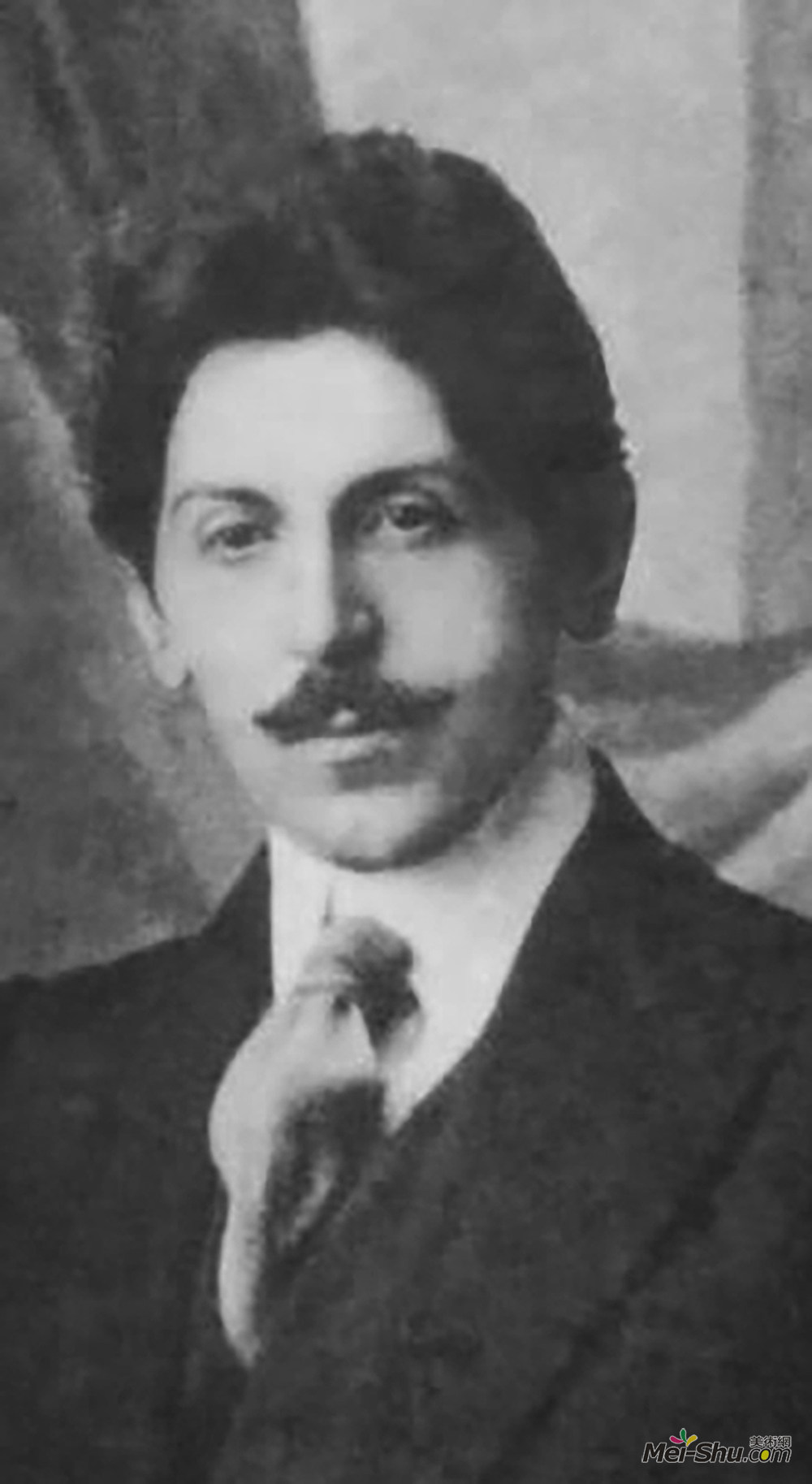
瓦哈拉姆盖费迪坚(Vahram Gayfedjian)
艺术家: 瓦哈拉姆盖费迪坚
生于: 1879年4月14日;佐治亚州
卒于: Yerevan, Armenia ;亚美尼亚耶勒万
国籍: 亚美尼亚
流派: 后印象派,抽象主义
领域: 绘画
Vahram Gayfedjian是二十世纪上半年亚美尼亚绘画大师之一。他在亚美尼亚艺术的发展中发挥了极其重要的作用,教了几代亚美尼亚画家,他们中的许多后来成为著名的大师。1879岁出生的Gayfedjian,在世纪之交,已经是一个成熟的人,他生命的最后几年恰好是太空时代的开始。他的创作活动沿着这条路进行——从19世纪末开始,在他1960去世前不久就结束了。这反映了他当时哲学、美学和伦理观的复杂交织。
盖非健和39的创造性进化。可以分为三个阶段。第一阶段“&";莫斯科”阶段包括两个时期:符号周期(1900和39;s)和合成(1910-1912)。他创作的符号周期,从19世纪末20开始,LED gayfedjian做出浪漫的思想,通过美容达到宣泄,他的艺术的基石。这就体现在他广泛的系列题为&;quot;装饰动机&;quot;和&;quot;颜色成分&;quot;。而他的&;quot;装饰动机&;quot;往往含有具象世界的元素,Gayfedjian &;# 39;摘要&;quot;颜色成分&;quot;完全站在第二十世纪的新艺术奥秘的门槛,就是给看不见的具象形态。在合成期间的作品,gayfedjian &;# 39;表达条件的位置,通过抽象的思考倾向现实取代。< / P > gayfedjian &;# 39;第二创作时期,的akhaltskha期(至)是当画家&;# 39;态度的现实主义的发展和更加深刻的。这一时期的倾向是将抽象的诗学和自然的观察与有形的确凿相结合。从合成到印象主义他的艺术活动的形式,但Gayfedjian从未针对其初始形态印象派培养。他把焦点从&;quot;时刻&;quot;范畴到&;quot;光&;quot;的范畴,不应用一种基于观察和视觉手段的分析方法,但作为一个形而上学的问题。< / P >第三,yerevanian的gayfedjian &期;# 39;创作涵盖了从1924年到1950年初&;# 39;美国实现计划所设定的革命的俄罗斯画家协会,他涉及到1934保护环境。画家的主题# &;39;作品曾在亚美尼亚苏区建设,但已经从1920 # &;39;S 1950 &;# 39;S、抒情山水开始支配他的画。正是在景观中,盖非健成功地表达了一种新的世界情感和精神高度的本质。因为他的目的不是现实的视觉呈现,但表达他的个人情感的自然现象,Gayfedjian极力释放他的视错觉的油画。不论曾经表示,Gayfedjian把艺术从他的第一个步骤,一个寻找新的、更具表现力的体现他生活信条的方法。观点也在变化,艺术语言也在变化,但信条的真正本质却没有改变。考虑到自己的实体粒子,因此能够理解善与恶的世界中的个人的快乐和忧伤,Gayfedjian生活内部应变。无论是二十世纪洪水也不可避免的痛苦、损失、生命的痛苦或冲突能够改变或打扰他相信世界是美好的,它已经从一开始就将永远如此。&;quot;清除附带的线,你会发现世界是美好的。&;quot;Alexander Block的这些话也可能属于Gayfedjian。Artist :Vahram Gayfedjian
Additional Name :Վահռամ Գայֆեջյան
Born : Georgia
Died :Yerevan, Armenia
Nationality :Armenian
Art Movement :Post-Impressionism,Abstract Art
Vahram Gayfedjian was one of the great masters of Armenian painting in the first half of the 20th-century. He played an extremely important role in the development of Armenian art, having taught several generations of Armenian painters, many of whom later became well-known masters.
Born in 1879, Gayfedjian was already a mature man at the turn of the century, and the final years of his life coincided with the beginning of the era of space. His creative activities proceeded along this path - beginning at the end of the 19th-century and ending shortly before his death in 1960 - reflecting a significant part of the complex interlacings of philosophical, aesthetic and ethical views of his time.Gayfedjian's creative evolution may be divided into three stages. The first, the "Moscow" stage consists of two periods: the symbolic period (the 1900's) and the synthetic (1910-1912). The symbolic period of his creative work, from the end of the 19th-century to the beginning of the 20th, led Gayfedjian to make a romantic ideology - to attain catharsis by means of beauty, the cornerstone of his art. This he embodied in his extensive series entitled "Decorative Motives" and "Colour Compositions". While his "Decorative Motives" tended to contain elements of the figurative world, Gayfedjian's abstract "Colour Compositions" stand completely on the threshold of new mysteries of 20th-century art, which strived to give figurative shape to the invisible. In works of the synthetic period, Gayfedjian's position in expressing conditional, abstract contemplations is replaced by an inclination towards reality. Gayfedjian's second creative period, the Akhaltskha period (1912-1923) is when the painter's attitude towards realism developed and became more profound. The tendency of that period was to assimilate abstract poeticism and natural observations with tangible definiteness. The form of his art moves from the synthetic to impressionism, yet Gayfedjian never aimed at cultivating impressionism in its initial form. He transferred the focal point from the "moment" category to the "light" category, not by applying an analytical approach based on observation and visual means, but as a metaphysical problem. The third, Yerevanian period of Gayfedjian's creations covers the years from 1924 through to the early 1950's. Fulfilling plans set by the Association of Painters of Revolutionary Russia, he was involved until 1934 in preserving his environment. The main theme of the painter's works was Soviet construction in Armenia, but already from the 1920's to 1950's, the lyric landscape began dominating his paintings. It was in landscapes that Gayfedjian succeeded in expressing the essence of a new world feeling and high spiritual mood. Since his purpose was not the visual presentation of reality, but the expression of his personal emotions by means of natural phenomena, Gayfedjian made every effort to free his canvases of visual illusions.However it may have been expressed, Gayfedjian moved in art from his very first steps, always searching for new, more expressive means of embodying the credo of his life. Points of views were changing, as was the language of art, yet the real essence of that credo remained unchanged. Considering himself a particle of Entity and for that reason capable of the personal joy and sorrow of comprehending the Good and Evil in the world, Gayfedjian lived a life of inner strain. Neither the 20th-century deluge nor the inevitable sufferings, losses, miseries or conflicts of life were able to change or disturb his belief that the world was wonderful, that it had been so from the beginning and would be so forever. "Erase incidental lines and you will find that the world is beautiful." These words of Alexander Block could just as well have belonged to Gayfedjian.